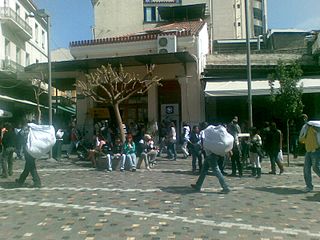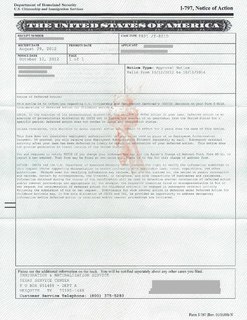
Operation Wetback was an immigration law enforcement initiative created by Joseph Swing, the Director of the United States Immigration and Naturalization Service (INS), in cooperation with the Mexican government. The program was implemented in June 1954 by U.S. Attorney General Herbert Brownell. The implementation of Operation Wetback was a result of Attorney General Henry Brownell's touring of Southern California in August 1953. It was here that he made note of the "shocking and unsettling" issue that was illegal immigration. The short-lived operation used military-style tactics to remove Mexican immigrants—some of them American citizens—from the United States. Though millions of Mexicans had legally entered the country through joint immigration programs in the first half of the 20th century, Operation Wetback was designed to send them back to Mexico.
Reforming the current immigration policy of the United States is a subject of political discourse. Immigration has played an essential part in American history. Some feel that the United States maintains the world's most liberal immigration policy. Others feel that areas like the European Union with its open border policies amongst the several countries points to the absurdity of such a claim. Several pieces of amnesty legislation aimed at preserving DACA were introduced in Congress in 2018. A package proposed by Rep. Bob Goodlatte (R-VA) that would have granted DACA beneficiaries a path to citizenship in return for a border wall and major cutbacks in family-based chain migration failed in the House with 193 votes, with 41 Republicans and all 190 Democrats voting no. A week later, an even greater amnesty package sponsored by Paul Ryan and the party leadership died in the House with only 121 votes. That law would have granted amnesty to almost two million illegal immigrants while maintaining the most important chain migration categories.DACA's future is currently unknown.
The Center for Immigration Studies (CIS) is an anti-immigration think tank and a SPLC designated hate group. It favors far lower immigration numbers, and produces analyses to further those views. The CIS was founded by historian Otis L. Graham and eugenicist and white nationalist John Tanton. The organization was founded in 1985 as a spin-off from the Federation for American Immigration Reform, and is one of a number of anti-immigration organizations founded by Tanton, along with FAIR and NumbersUSA.

Illegal immigration to the United States is the process of migrating into the United States in violation of federal immigration laws. This can include foreign nationals (aliens) who have entered the United States unlawfully, as well as those who lawfully entered but then remained after the expiration of their visas, parole, TPS, etc. Illegal immigration has been a matter of intense debate in the United States since the 1980s.

Illegal immigration is the migration of people into a country in violation of the immigration laws of that country or the continued residence without the legal right to live in that country. Illegal immigration tends to be financially upward, from poorer to richer countries. Illegal residence in another country creates the risk of detention, deportation, and/or other sanctions.

The actual size and the origin of the undocumented immigrant population in the United States is uncertain and is difficult to ascertain because of difficulty in accurately counting individuals in this population. Figures from national surveys, administrative data and other sources of information vary widely. By all measures, the population of undocumented immigrants in the USA has declined substantially since 2007. The number of border apprehensions has substantially declined since 2000, the peak year, but more than doubled in the most recent fiscal year to approach 2007 levels.
Sanctuary city refers to municipal jurisdictions, typically in North America, that limit their cooperation with the national government's effort to enforce immigration law. Leaders of sanctuary cities say they want to reduce fear of deportation and possible family break-up among people who are in the country illegally, so that such people will be more willing to report crimes, use health and social services, and enroll their children in school. In the United States, municipal policies include prohibiting police or city employees from questioning people about their immigration status and refusing requests by national immigration authorities to detain people beyond their release date, if they were jailed for breaking local law. Such policies can be set expressly in law or observed in practice, but the designation "sanctuary city" does not have a precise legal definition. The Federation for American Immigration Reform estimated in 2018 that 564 U.S. jurisdictions, including states and municipalities, had adopted sanctuary policies.

Immigration to Greece percentage of foreign populations in Greece is 7.1% in proportion to the total population of the country. Moreover, between 9 and 11% of the registered Greek labor force of 4.4 million are foreigners. Migrants additionally make up 25% of wage and salary earners.

Agriprocessors was the corporate identity of a slaughterhouse and meat-packaging factory based in Postville, Iowa, best known as a facility for the glatt kosher processing of cattle, as well as chicken, turkey, duck, and lamb. Agriprocessors' meat and poultry products were marketed under the brand Iowa Best Beef. Its kosher products were marketed under various labels, including Aaron’s Best, Shor Habor, Supreme Kosher, and Rubashkins.

The Postville raid was a raid at the Agriprocessors, Inc. kosher slaughterhouse and meat packing plant in Postville, Iowa, on May 12, 2008, executed by the U.S. Immigration and Customs Enforcement (ICE) division of the Department of Homeland Security together with other agencies.

The United States government holds tens of thousands of immigrants in detention under the control of Customs and Border Protection and the Immigration and Customs Enforcement (ICE). Immigrants are detained for unlawful entry to the United States, when their claims for asylum are received, and in the process of deportation and removal from the country. During Fiscal Year 2018, 396,448 people were booked into ICE custody: 242,778 of whom were detained by CBP and 153,670 by ICE's own enforcement operations. A daily average of 42,188 immigrants were held by ICE in that year. In addition, over twelve thousand immigrant children are housed by facilities under the supervision of the Office of Refugee Resettlement's program for Unaccompanied Alien Children. Prior to referral to these other agencies, the CBP holds immigrants at processing centers; between mid-May and mid-June 2019, it held between 14,000 and 18,000 immigrants.
The economic impact of undocumented immigrants in the United States is challenging to measure, and politically contentious. Research shows that undocumented immigrants increase the size of the U.S. economy/contribute to economic growth, enhance the welfare of natives, contribute more in tax revenue than they collect, reduce American firms' incentives to offshore jobs and import foreign-produced goods, and benefit consumers by reducing the prices of goods and services. Economists estimate that legalization of the undocumented immigrant population would increase the immigrants' earnings and consumption considerably, and increase U.S. gross domestic product.
The Ghana Immigration Service (GIS) is in charge of the removal and deportation of illegal immigrants in Ghana.

The 2006 Swift raids were a coordinated effort by U.S. Immigration and Customs Enforcement (ICE) to detain and deport people who are undocumented.

Deferred Action for Childhood Arrivals, colloquially referred to as DACA, is a United States immigration policy that allows some individuals with unlawful presence in the United States after being brought to the country as children to receive a renewable two-year period of deferred action from deportation and become eligible for an employment authorization document in the U.S. To be eligible for the program, recipients cannot have felonies or serious misdemeanors on their records. Unlike the proposed DREAM Act, DACA does not provide a path to citizenship for recipients. The policy, an executive branch memorandum, was announced by President Barack Obama on June 15, 2012. U.S. Citizenship and Immigration Services (USCIS) began accepting applications for the program on August 15, 2012.
Undocumented youth in the United States are young people living in the United States without U.S. citizenship or other legal immigration status. An estimated 1.1 million undocumented minors resided in the U.S. as of 2010, making up 16% of the undocumented population of 11 million. Undocumented students face unique legal uncertainties and limitations within the United States educational system. They are sometimes called the 1.5 generation, as they have spent a majority of their lives in the United States.

Deportation and removal from the United States occurs when the U.S. government orders a person to leave the country. In fiscal year 2014, Immigration and Customs Enforcement conducted 315,943 removals. Criteria for deportations are set out in 8 U.S.C. § 1227.
A sanctuary campus is any college or university, typically in North America and Western Europe, that adopts policies to protect members of the campus community who are undocumented immigrants. The term is modeled after "sanctuary city", a status that has been adopted by over 30 municipalities. Proposed policies on sanctuary campuses include:

Immigration policy, including illegal immigration to the United States, was a signature issue of former U.S. president Donald Trump's presidential campaign, and his proposed reforms and remarks about this issue generated much publicity. Trump has repeatedly said that illegal immigrants are criminals. Despite Trump never explicitly mentioning correlation, critics have argued that there is an increasing amount of evidence that immigration does not correlate with higher crime rates. Entering the US illegally is a federal crime, making the person who does that a criminal(8 U.S. Code § 1325).
The issue of crimes committed by illegal immigrants to the United States is a topic that is often asserted and debated in politics and the media when discussing Immigration policy in the United States.











